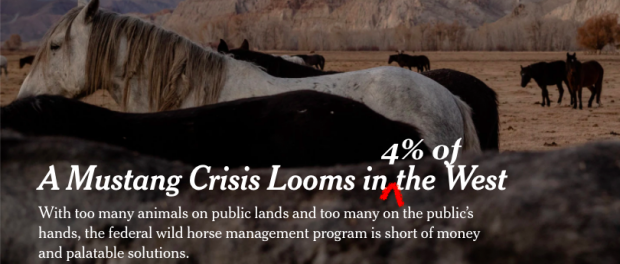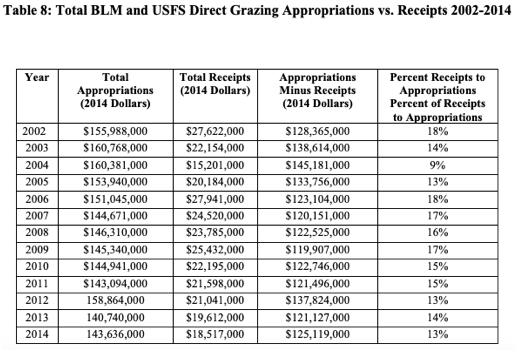CORRECTIONS WATCH
Fact-checking errors and omissions in the New York Times
What happens when editors ignore errors by a Pulitzer-prize winning journalist that contradict his own book and government sources? The public is misinformed, and someone else makes money off it.
 A problem on 4% of the West isn't a compelling headline. It is, however, a truthful one.
A problem on 4% of the West isn't a compelling headline. It is, however, a truthful one.
Sent to nytnews@nytimes.com on April 4, 2020. The New York Times did not respond. No corrections were made.
Dear Editor:
Did anyone fact-check Dave Philipps’ 3/22/20 New York Times article, “A Wild Horse Crisis Looms in the West”? There are a quite a few factually incorrect statements in it according to data from the Government Accountability Office (GAO), the Bureau of Land Management (BLM), and Mr. Philipps’ own book, “Wild Horse Country.”
Had Philipps included this data, his article would have taken a very different direction, beginning with the headline. This must be fixed.
For starters, only 31.6 million acres out of the roughly 760 million acres of western state land in the lower 48 have any wild horses on them at all (and at least ten times as many cattle, according to the BLM’s rangeland database). [Update: US Department of Agriculture figures show 25 times more beef cattle on public lands than wild horses in 2020 ).
31.6 million acres is only 4% of “the West” — not the entire “from the mountains to the valleys” sweeping expanse that Philipps conjures up for Times readers from beginning to end.
That small but significant statistic appears in the introduction to “Wild Horse Country” but is left out of Phillips’ article. It’s a serious omission.
The Times article omits a second critical piece of data: 250+ million acres of western public lands are grazed by cattle and sheep, 87% of which has ZERO wild horses on it. Again, this is not “the West” but it is more of “the West” than that 4% of public lands with mustangs and cows on it in Phillips’ reporting for the New York Times.
Western academics and environmental groups (Western Watersheds Project, Public Employees for Environmental Responsibility, the Center for Biological Diversity, among others) have all exposed cattle and sheep ranching as the primary source of watershed damage, noxious weeds, desertification, wildfires, and wildlife habitat destruction and endangerment on U.S. public lands. So have New York Times writers Timothy Egan, Christopher Ketcham, Stephen Nash and Philipps in “Wild Horse Country.”
But the actual truth — the small footprint of wild horses; the large footprint of livestock — is completely flipped by Philipps and his mostly unnamed sources in the Times article. In paragraph after paragraph, they set up wild horses as cutting a wide swath of environmental destruction:
All over the West, similar scenes have played out as the federal government fights to control the number of wild horses roaming public lands. Managers say they need to keep the herds down so they don’t destroy delicate native species habitat and threaten the livelihoods of ranchers.
Mustangs have already destroyed fragile desert springs in some places, and the birds, snakes and butterflies that depend on them… “We are going to get to the point where the public lands are going to be almost unusable by anything.
Bureau officials warn that the mustang herds are a looming catastrophe for the land, and there is no cheap or obvious solution.
Back in “Wild Horse Country” (pp. 218-220), Philipps vindicates mustangs of these charges —
In 2016, … the West held about seventy-seven thousand wild horses. At the same time, there were about seven hundred thousand cattle on BLM land. If there is a shortage of grass, muddy springs, invasive weeds, and deteriorating range in the West, horses can hardly take the blame, or even most of it.
— and blowing up yearly budget appropriations:
Ranchers chafe against money misspent on wild horses… But the wild horse budget pales in comparison to federal subsidies spent on public lands ranchers. Almost any way you look at it, [the livestock program] is a losing proposition for the American Public.
According to the most recent GAO report (2005) on livestock grazing:
The 10 federal agencies’ grazing fees generated about $21 million in fiscal year 2004 — less than one-sixth of the expenditures to manage grazing… The formula used to calculate the BLM and Forest Service grazing fee incorporates ranchers’ ability to pay; therefore the current purpose of the fee is not primarily to recover the agencies’ expenditures or to capture the fair market value of forage. As a result, BLM’s and the Forest Service’s grazing receipts fell short of their expenditures on grazing in fiscal year 2004 by almost $115 million.
Twelve years of BLM and US Forest Service (USFS) data compiled by a Center for Biological Diversity (CBD) report shows even bigger losses to taxpayers —

— and the above reflects only direct program expenditures and losses for the federal grazing lease program according to the CBD report:
The federal grazing subsidy is even larger when all costs to the taxpayer are accounted for. Indirect costs for livestock grazing include portions of different federal agencies budgets, such as the USDA Wildlife Services, which expends money to kill thousands of native carnivores each year that may threaten livestock; U.S. Fish and Wildlife Service, which expends part of its budget for listing species as threatened or endangered resulting from harm by livestock grazing; and other federal land management agencies that expend money on wildfire suppression caused by invasive cheat grass that is facilitated by livestock grazing. The full cost of the federal grazing program is long overdue for a complete analysis.“
Indirect costs push total grazing subsidies to between $500 million and $1 billion a year, according to the CBD and environmental group WildEarth Guardians. That’s five to ten times higher than what mustangs are projected to cost over their lifetimes in Philipps’ Times article:
“Capturing all the excess horses and caring for them in storage for the rest of their lives could cost up to $3 billion. Doing nothing may prove costly, too.“
Philipps doesn’t provide a source for that $3 billion figure. It isn’t on the BLM’s website or in any of its press releases, and the BLM hasn’t accounted for it (I inquired), so there’s no fact-checking the math. Does a guestimate belong in the Times?
Let’s say that that it does. That projected $3 billion translates to $1 billion over a decade, given horses’ average 30-year lifespan in captivity. That’s way cheaper than the livestock grazing subsidy program, which affects twelve times more public land.
Public lands ranching isn’t even an economic engine in the western U.S. as Philipps points out in “Wild Horse Country”:
Though cattle cover much of Nevada, the whole industry employs fewer people than a single large casino in Las Vegas. … the federal lands in the West where cattle are run cover the same number of square miles as all the states along the East Coast, those ranchers only make up three percent of all cattle growers…they produce less than one percent of all beef. If all public-land ranching west of the Rockies were ended, many studies have suggested, the industry would hardly notice.
The Times has done excellent reporting on mining and energy development on public lands. Cattle ranching impacts way more of the people’s land, affecting the shrinking of national monuments and endangered species protections to the killing of predators (wolves, cougars, grizzlies) as well as other ruminants (bison in Yellowstone; mountain goats and bighorn sheep); the loosening of NEPA requirements; armed rebellions (the Bundy clan), etc.
I get that “A Wild Horse Crisis Looms on 4% of the West” doesn’t quite pack the punch that Philipps’ original headline does, along with the rest of his article. But 4% of “the West” is not, can never be considered “the West.” You can’t let that stand. New York Times readers deserve better.
I’m a journalist (see bio below), New York Times subscriber and former employee. I’m happy to supply sources, if needed.
Please let me know what you plan to do regarding corrections and thanks for your time.
Sincerely,
Vickery Eckhoff
address and phone, etc.
Vickery Eckhoff is a journalist and screenwriter. She has reported on the pipeline of America’s race horses and mustangs to slaughter and subsidized ranchers on public lands who are on Forbes “Billionaires” and “Rich” lists — including Walmart, Hilton and Hewlett-Packard heirs; The JR Simplot Corp. and family members; Barrick Gold; Koch Enterprises; and Ted Turner.
Vickery’s articles have appeared in Forbes, Newsweek, Salon, Alternet, The Daily Beast, and have served as source material for numerous articles and two books: Stephen Nash’s “Grand Canyon for Sale: Public Lands versus Private Interests in the Era of Climate Change” and Christopher Ketchum’s “This Land: How Cowboys, Capitalism and Corruption are Ruining the American West.”
Her screenplay, “The Judas Horse,” on the closing of one of the last horse slaughterhouses in America, is based on her Forbes article, “Texas Mayor Paula Bacon Kicks Some Tail.”
**UPDATE**
PS: if you read Mr. Philipps article, you’ll note something interesting at the bottom:
Correction: March 23, 2020
An earlier version of this article misstated the name of an area near Challis, Idaho. It is Spar Canyon, not Spur Canyon.
Good to know the Times is concerned about spelling.
Please leave a comment below, follow me @viglet on twitter and read these other Daily Pitchfork posts pushing mainstream news outlets to correct their errors:
Fact-checking 13-year old photographic images in the Washington Post (1/22/21)
Fact-checking 9 errors in the Washington Post, Seattle Times and Houston Chronicle (12/12/20)
Fact-checking The New York Times: Sources claim wild horse damage, but photos show cattle did it.(12/12/20)
Fact-checking the New York Times: Maps and data expose cattle, not wild horses, as looming crisis. (12/15/20)

Fantastic analysis
Thank you
Please keep writing! There is a mad marathon to round up and kill as many wild wild horses as possible now that we have the ability and desire to STOP this murder.